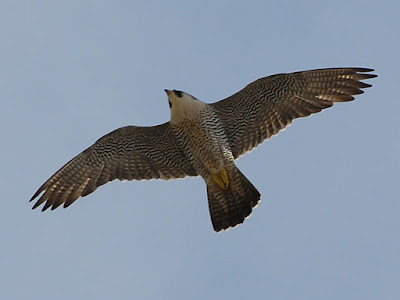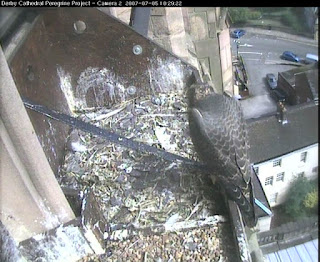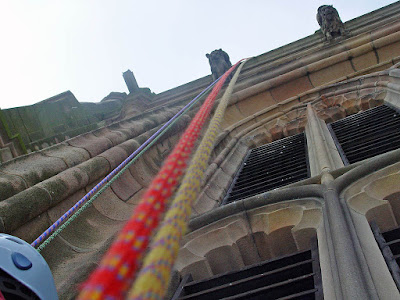
This morning, en route to work, I diverted to check on my local pair of hobbies. These engaging little falcons are a good deal smaller than our peregrines......and much harder to find!
So I was pleased to see what I assume was the male sitting on his favourite dead oak branch. With his back turned to the warmth of the sun, he was quietly preening, behaviour exactly mimicking that of the male peregrine I had watched on Sunday morning on the cathedral. High up near the top of this old oak, where the crow's nest that was commandeered back in May is situated, I could hear its mate calling which gives hope that this pair have managed to keep their brood alive despite the endless days of rain.
Hobbies are acrobatic fliers and fast enough to catch swifts, swallows and martins on the wing, as this fine watercolour by Peter Partington demonstrates.
With their rust-coloured thighs and deeply streaked breasts, their white cheeks and dark moustaches, hobbies are handsome birds for sure. No wonder that they attract the attentions of bird artists like Peter and, in more modern style, Greg Poole.
Greg's painting captures not just the bird but also its liking for dragonflies and damselflies and the wetland habi tat they occupy. In this case it is the low-lying Somerset Levels, no doubt severely flooded still.
tat they occupy. In this case it is the low-lying Somerset Levels, no doubt severely flooded still.
 tat they occupy. In this case it is the low-lying Somerset Levels, no doubt severely flooded still.
tat they occupy. In this case it is the low-lying Somerset Levels, no doubt severely flooded still.While my very amateur digi-scoped photo below leaves a lot to be desired for sharpness, it does at least hint at the sense of mystery which surrounds  this magic falcon, here keeping watch from its oak tree.
this magic falcon, here keeping watch from its oak tree.
 this magic falcon, here keeping watch from its oak tree.
this magic falcon, here keeping watch from its oak tree. Before long, these birds and their offspring will begin their southward migration which will take them down through France, Spain and over the Sahara to wintering grounds in southern Africa. Here they will wander across vast plains, savannah and miombo woodland, searching for thunderstorms which trigger termites to swarm in their thousands, providing a ready supply of protein-rich food.
So, a very different sort of winter lies in wait for these hobbies than the one the cathedral peregrines will experience. In complete contrast, the fledglings will stay within 50-100 miles of Derby, perching on pylons, aerial masts, tall buildings and trees too no doubt, coping with whatever our winter has to throw at them.
Nick BPs. And just so you know what this bird really looks like, here's a great photograph by John Miller, taken with his permission from surfbirds.com - a website which displays excellent photos of birds such as this for all to see and admire. Please note that this photo should not be used commercially or for profit without the express permission of the photographer.


.jpg)













 In our own garden and to our great delight, a pair of spotted flycatchers recently adopted a purpose-built nest box on the house right outside the kitchen window. Judging by the late laying date, this pair must have nested elsewhere in May/June and now be trying again, perhaps having failed first time round.
My photos show the nest box tucked under the gutter....a tad smaller and easier to construct than the peregrine platform - and somewhat easier to put up as well....plus one of an adult spotted flycatcher (photographer unknown). The lowest photo, taken through the window, shows an adult peering out of the box while brooding its chick.
The two eggs hatched some ten days ago but the availability of flying insects since has been severely restricted by days of rain and cool temperatures and we fear for the one surviving chick which is still quite un-feathered even now.
In our own garden and to our great delight, a pair of spotted flycatchers recently adopted a purpose-built nest box on the house right outside the kitchen window. Judging by the late laying date, this pair must have nested elsewhere in May/June and now be trying again, perhaps having failed first time round.
My photos show the nest box tucked under the gutter....a tad smaller and easier to construct than the peregrine platform - and somewhat easier to put up as well....plus one of an adult spotted flycatcher (photographer unknown). The lowest photo, taken through the window, shows an adult peering out of the box while brooding its chick.
The two eggs hatched some ten days ago but the availability of flying insects since has been severely restricted by days of rain and cool temperatures and we fear for the one surviving chick which is still quite un-feathered even now.







 to spoil her appetite before the next succulent blackbird, thrush or feral pigeon is readied, and perhaps also savouring a moment of the dry weather., too.
to spoil her appetite before the next succulent blackbird, thrush or feral pigeon is readied, and perhaps also savouring a moment of the dry weather., too.
